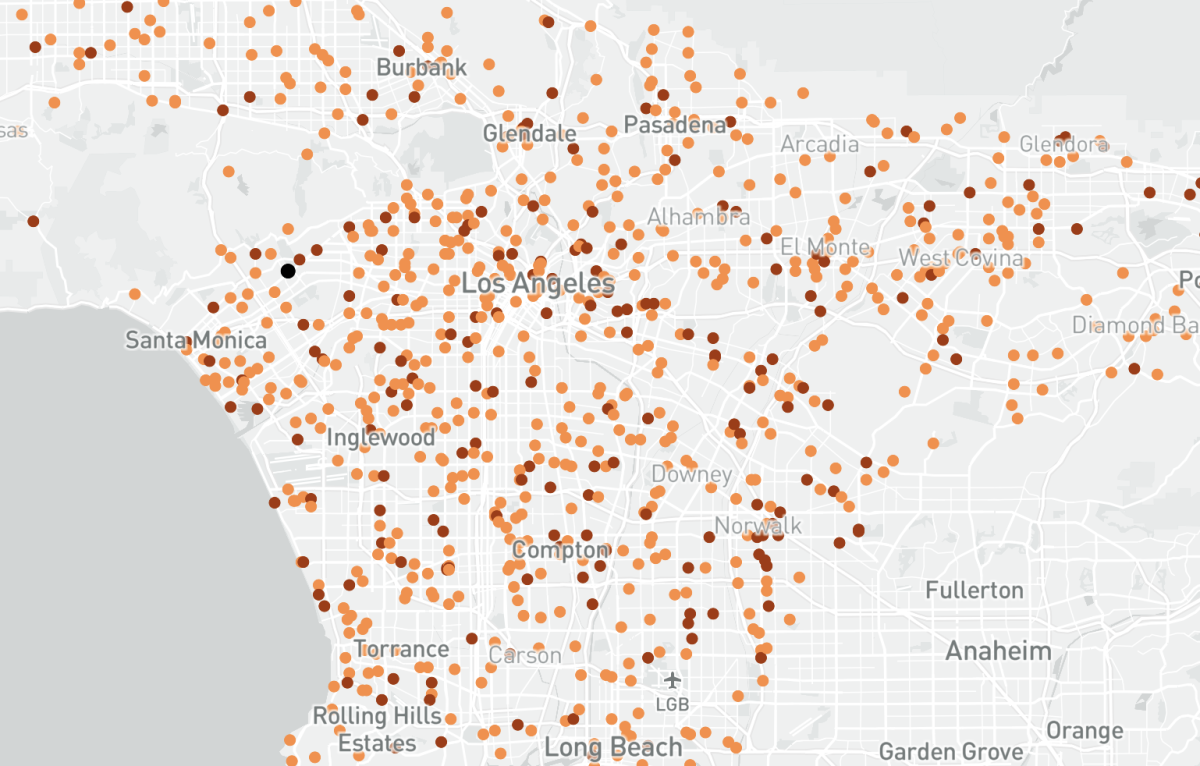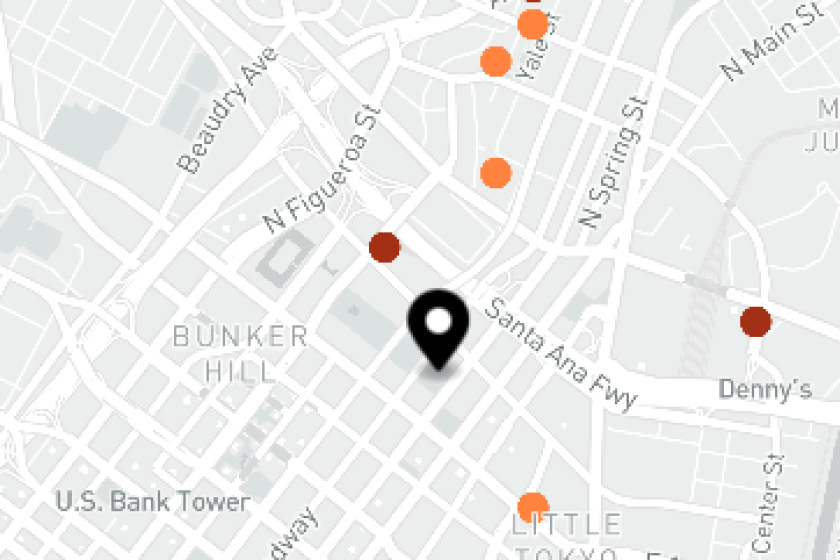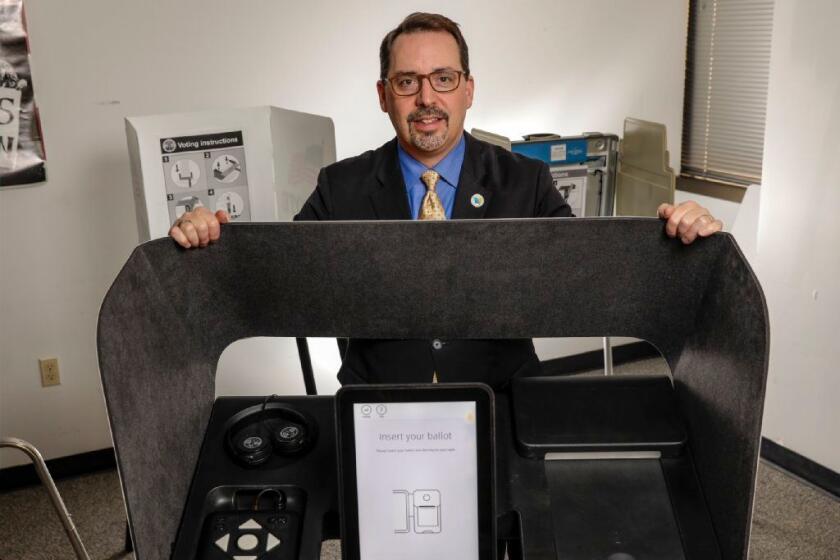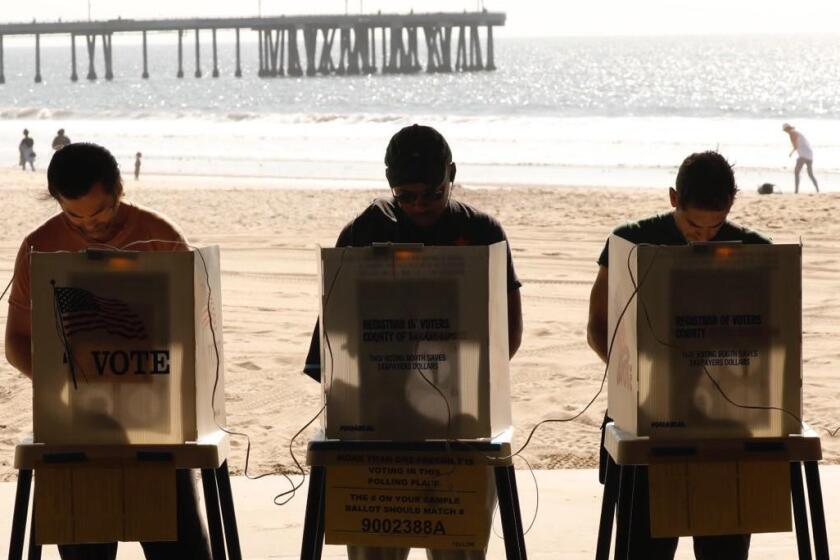L.A. is radically altering the way we vote. Get ready for big changes, possible problems

Voters are about to get their first peek at the future of balloting in Los Angeles County, where officials have spent years building a new voting system.
As next monthâs presidential primary election approaches, officials are putting the finishing touches on a $300-million overhaul of a system that hasnât had major upgrades in decades. Scrutiny and expectations will be high in the wake of the botched vote counting in the Iowa caucuses.
While the changes run the gamut, from expanded voting schedules to modernized balloting devices, the most significant change will be apparent as soon as many residents go to vote.
Thatâs because the number of polling places has been dramatically reduced from the last presidential primary, from more than 4,500 to about 960.
But while many voters will discover that their traditional polling place has closed, they will also have more voting options.
Under the new system, voters who live in L.A. County are no longer limited to one polling place. They are able to cast their ballot at any voting center from Long Beach to Lancaster, regardless of where they live in the county. The new center addresses were recently made public.
Most of the locations are in quasi-public spaces familiar to voters: schools, community buildings, parks and fire houses. But a few are in unexpected places, such as the Sherman Oaks Galleria, the Hollywood Hotel, and a youth center on Dockweiler Beach. Also making the list were a French restaurant in Santa Clarita and an auto dealership in Burbank.
Once inside, voters will experience several innovations.
The ballot machines of the past have been replaced with modern touch-pad ballot-marking devices. Ballots will have larger type and clear design, and they will be offered in 13 different languages. There will be audio headsets available for the voters with disabilities, or for those who prefer to listen in a different language. And residents will be able to cast their votes up to 11 days before the March 3 election. Hundreds of the centers begin opening for early voting on Feb. 22.
The modernization plan came about due to the Voterâs Choice Act, a state law which encouraged counties to invest in mail balloting while also offering a more flexible experience for those wishing to cast ballots in person. The county has about 5.4 million registered voters, and roughly 3.4 million of them have been mailed a ballot.
County officials and voting rights advocates say they are working hard to avoid confusion and ensure the public understands their new options.
âYouâre not tied into only being able to vote in one specific voting place, as you were before,â said Justin Levitt, a political science professor at Cal State Long Beach. âOf course, for voters going to these centers, this is going to be a new experience.â
Starting in spring, some 5.2 million Los Angeles County residents will change the way they vote. If the plan goes awry â either in the March primary or in the November election, in which President Trump is likely to be on the ballot â blame will likely fall on Dean Logan, Los Angeles Countyâs registrar-recorder and clerk.
This is the first election cycle in which L.A. County â which has a relatively high percentage of Election Day voters compared to other counties across the state â will open centers in the weeks before and the day of the March 3 primary. Anyone can vote in the centers, even if they received â but havenât yet submitted â a mail ballot already. Party switching and on-site registration is also possible.
With the shift to new voting centers, thousands of historically familiar polling places will not be used this election. In the June 2016 primary, for example, Long Beach had 247 polling locations. This election, it will have 33, according a Times analysis. In Santa Clarita, there were 92 four years ago. Now there are 18, the data show.
Despite this, officials said the new systemâs flexibility will provide voters with plenty of convenient options.
âI live in Whittier, but if I went to a voting center in downtown L.A., I would get a Whittier ballot,â Dean Logan, the registrar-recorder/county clerk, who has led the countyâs ambitious effort to overhaul its voting system, told the Board of Supervisors last month. âThere are no longer wrong places to vote in L.A. County. Every voting location is the right place to vote.â
The new locations have been spread out relatively evenly across the county. In deciding which locations to select, the county considered neighborhoodsâ proximity to mass transit, household income and vehicle ownership. Another key factor was historic rate of mail voting.

More locations are open in areas in the center of the county, such as Los Angeles, which has lower mail voting rates. Areas with high mail voting adoption â Malibu, for example â have fewer.
Ahead of the election, the centers will be open from 8 a.m. to 5 p.m. About 75% of the centers will be open four days, from Feb. 29 to March 2. The rest will be open 11 days, from Feb. 22 to March 2. All of them will be open from 7 a.m. to 8 p.m. on March 3, the day of the primary.
Once inside the centers, voters will use new electronic devices to mark a newly designed ballot, with larger typography and options for different languages and accessibility. The devices arenât connected to the internet, and ballots will still be cast on paper, allowing for an audit later.
In the run-up to the change, voting rights advocates have worried that the centers might catch voters accustomed to the past experience off guard. County officials working with community groups have held hundreds of public meetings and presentations in an effort to get the word out.
How do I vote? Will I get a ballot in the mail? A new procedure will change how some Californians cast ballots. Hereâs how to vote in the California primary election.
âThere was very poor attendance. Maybe more could have been done to have promoted those meetings a little bit more,â said Marilu Guevara, executive director of the League of Women Voters of Los Angeles, which helped inform residents of the new centers.
She supports the changes to the system but worries about educating the public, particularly older voters, though she hopes theyâll find the the extra days that the centers will be open useful.
âThereâs more concern around finding ways to reach a lot of those communities,â she said.
In addition to its media marketing, Loganâs office is sending three direct mailings to voters. One recently went out to all 3.5 million postal consumers in the county with a small-type list of voter centers. Some have been added since that mailing.
For some voters, the shift to voting centers might be less jarring. Marina Del Rey Middle School on Braddock Drive in Los Angeles, which was a polling place in past elections, will remain a voting center, for example. Hundreds of other former precinct polling places have been converted to voting centers.
But most former polling places will be closed, and voting officials say they plan to place signs at those locations to remind the public about new locations. It remains unclear whether the fewer number of centers will be able to accommodate a crush of last-minute voters.
âI hope that the county is prepared,â Levitt said. âIâm certain there will be challenges, because L.A. County is going to have a harder time predicting how many people will show up at each vote center.â
More to Read
Sign up for Essential California
The most important California stories and recommendations in your inbox every morning.
You may occasionally receive promotional content from the Los Angeles Times.














